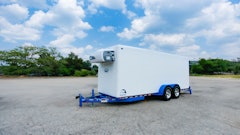
Sustainability concerns are driving progress in every industry, and food logistics is no exception. Throughout the supply chain, industry stakeholders are looking to reduce carbon emissions, enhance efficiency, and contribute to a greener world.
One target area today lies within refrigeration technology. Specifically, hydrofluorcarbons (HFCs) have long been deployed as refrigerants in many critical applications, from cold chain transport and storage to supermarket shelves. But in recent years, HFCs have been targeted for their high global warming potential (GWP) and are now being phased out; the 2020 American Innovation and Manufacturing Act in the United States, for example, aims to promote the use of alternatives beginning in 2025 and beyond.
This shift will come with its challenges as refrigeration equipment OEMs embark on new strategies to move away from what has been a reliable refrigerant for decades.
One of those challenges is the interaction with critical fluids and lubricants essential to compressor operation and how they interact with new alternative refrigerant options.
First examine the lubricating requirements of refrigeration compressors, how those lubricants interact with the refrigerant, and how the industry can move forward successfully.
Meeting the needs of compressors
First, it’s helpful to understand the role that lubricating fluids play in refrigeration compressors that enable cold storage and transport.
 Lubrizol
Lubrizol
Refrigerator compressors are at the core of the refrigeration cycle. First, the compressor takes low-pressure, low-temperature refrigerant vapor and compresses it into a high-temperature/pressure refrigerant vapor. This vapor then goes into the condenser where it cools the refrigerant vapor into a liquid. The liquid refrigerant is then boiled off in the evaporator and the refrigerant vapor then heads back to the compressor and begins the cycle again. Throughout this process, lubricating fluids are responsible for enabling the movement of the refrigerant, as well as protecting metallic parts in the compressor and enabling them to function efficiently.
Lubricant performance can be impacted by external operational factors. For example, a compressor located within an engine room may experience high temperatures, requiring the compressor to work harder to provide cool temperatures, creating heightened stress on the lubricant. Conversely, lubricants operating in extremely cold environments can face other challenges. Here, flow and viscosity can be compromised, creating performance issues that may lead to premature wear on compressor parts. These operating environment conditions, among other important considerations, all influence lubricant selection for compressor OEMs.
Adaptation to low GWP refrigerants
The shift from HFCs to low GWP refrigerants is important, but it simultaneously poses a significant complication for lubricant functionality in compressor applications. It’s natural for OEMs to ask: If my current lubricant is not compatible with a lower GWP refrigerant, how can I determine a successful alternative? Deep application knowledge, formulation expertise, and successful collaboration will all be key factors in bridging the gap.
The first hurdle is the sheer variety of low GWP alternatives gaining market traction. HFCs have been the lone dominant refrigerant for years—now, a multitude of other options have shown promise, each of which interact with common lubricant technology differently. Alternative refrigerants include:
· Hydrofluoroolefins (HFOs)
· HFO blends
· CO2 (Carbon Dioxide)
· NH3 (Ammonia)
Such variety complicates lubricant compatibility across a broad range of applications. For example, optimal solubility between a potential refrigerant and a lubricant is an important characteristic, but not all formulations will behave the same when interacting with differing refrigerant options. Elsewhere, the lubricant’s ability to mix with the refrigerant in a single phase is critical. These performance necessities will require tailored approaches from OEMs and fluid providers to achieve optimal functionality while accommodating low-GWP refrigerants.
Formulation science’s role in essential performance
Overcoming the challenges associated with widespread low GWP refrigerants will depend on strong working relationships between lubricants providers, refrigeration compressor OEMs, and refrigerant manufacturers.
While most refrigeration OEMs have followed consistent compressor designs for years based on HFC refrigerant availability, the transition to low GWP options has caused design divergence. These changes, coupled with operating conditions and other factors, will create distinct requirements from specified lubricants—close collaboration with their lubricants providers will be essential for OEMs to identify formulations that contribute to optimal performance, reliability, and longevity.
To suit this variety of needs, the ideal finished fluid partner should offer lubricant solutions specifically designed for compressor type, operating conditions, and refrigerant gas selection, based on a deep understanding of the necessary criteria the system requires. A “chemistry agnostic” approach can be beneficial here, with your supplier partner offering the best lubricant option for the given application.
What else to look for? Deep experience throughout the refrigeration space, backed by expertise and technical support, will be essential as OEMs continue to navigate the new frontier of low GWP refrigerants. A global network of research and development, production, supply chain, packaging and distribution is also helpful, enabling OEMs to successfully contend with global supply chain complexities while managing the transition to a low GWP refrigerant future.
The low GWP future is here, and cold chain professionals must develop the right strategies to maintain reliability every step of the way. The development and deployment of compatible lubricants for compressor technology are essential, and close collaboration and technological partnership are the only way to make it happen.


















